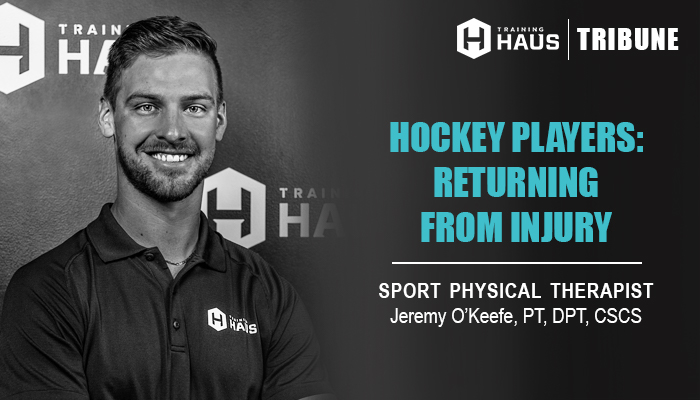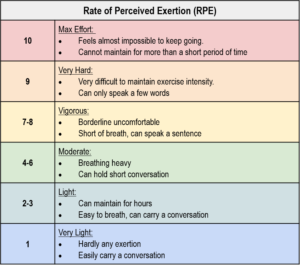
A Hockey Players’ Guide to Returning to the Ice
The first question hockey players often ask me when rehabbing from surgery or injury is, “When can I get back on the ice?”
The response to this question is often complex, with factors such as strength, tissue healing, and injury-risk reduction all guiding the decision-making process.
At Training HAUS, our ACE Hockey program has basic criteria we feel all players need to meet before hitting the ice for the first time.
1. Do not put the cart in front of the horse. Daily activities, your strength and conditioning program, and basic movement quality drills should be well tolerated prior to returning to the ice.
2. Test don’t guess. Simple tests such as single leg squats, hops, and isokinetic/isometric strength testing can offer a lot of information toward player readiness.
3. Your hips don’t lie. Regardless of injury, it is important to ensure your hip health is up to par. Hockey athletes who return to the ice with deceased hip strength are at 17x greater risk of a groin strain! The greatest prevalence of overuse injury, such as a groin strain, is during the first eight weeks while returning to the ice.
I passed my return to hockey criteria! Now what?
It’s incredibly important to know and understand the things you should avoid/ease into upon your return.
This often requires an understanding of biomechanics and balancing appropriate intensity. Furthermore, this is a critical time for athletes. It can weigh on confidence and feels like a measuring stick for getting back to playing the sport they love.
From a physical therapist’s perspective, this often creates similar emotions, but for different reasons. You have seen the hard work and dedication the athlete has put in during their rehab. You have checked, double checked, and triple checked your objective measures to make sure you are providing a safe environment for the athlete to return to. Then you remember… there is no way to mimic the minimal friction of a 3 mm steel blade on ice. *Throws papers in the air*
The first time back on the ice is exciting! Remember to keep the main things, the main things. Have a plan and stick to it!
1. Set goals before you skate:
- Introduce basic skills (forward skating, passing, shooting).
- Progress to advanced skills (transitioning, escapes, game simulated drills).
- Join team play (non-contact games, odd man rushes).
- Add contact (progress time with tolerance).
2. Set intensity:
- I like to use a rating of perceived exertion. It’s an easy-to-understand scale which helps you to self-regulate the amount of stress you are placing on your body. The first time you step on the ice, may be weeks to months since the last time. At this point, you need to be more like a Prius than a Ferrari. Beginning at lower intensities, 2-3 or Light, and building up to Max Effort is important to allow your body to adjust to new demands.
3. Follow soreness rules!
- Often the tissue that is recovering will tell us what it needs. When returning to the ice, it is important to follow a stepwise progression. For example, you may start with simple skating drills the first time on the ice with each time introducing greater demands such as abrupt change of direction or escapes. With each new step, you should be assessing the amount of soreness you are experiencing. Whether to proceed with caution or forge forward, the rules below will help guide you:
In Conclusion
Successfully returning athletes to the rink is one of my passions as a physical therapist. At the Training HAUS, we have taken the variables out of the return to ice progression. Myself and my colleague, Justin Nicol, have started the ACE Hockey program to help return hockey athletes to the ice safely under the supervision of a skilled physical therapist. If you have questions about getting back on the ice and in the game or want to take your game to the next level contact the Training HAUS at 952-456-7650.
– Jeremy O’Keefe, PT, DPT, CSCS | Sports Physical Therapist
References:
Brunner R, Bizzini M, Niedermann K, Maffiuletti NA. Epidemiology of Traumatic and Overuse Injuries in Swiss Professional Male Ice Hockey Players. Orthop J Sports Med. 2020 Oct 19;8(10):2325967120964720. doi: 10.1177/2325967120964720. PMID: 33178879; PMCID: PMC7592329.
Tyler, Timothy & Nicholas, Stephen & Campbell, Richard & McHugh, Malachy. (2001). The Association of Hip Strength and Flexibility With the Incidence of Adductor Muscle Strains in Professional Ice Hockey Players. The American journal of sports medicine. 29. 124-8. 10.1177/03635465010290020301.
Fees M, Decker T, Snyder-Mackler L, Axe MJ. Upper extremity weight-training modifications for the injured athlete. A clinical perspective. Am J Sports Med. 1998;26(5):735. Copyright ©1998 SAGE Publications.



